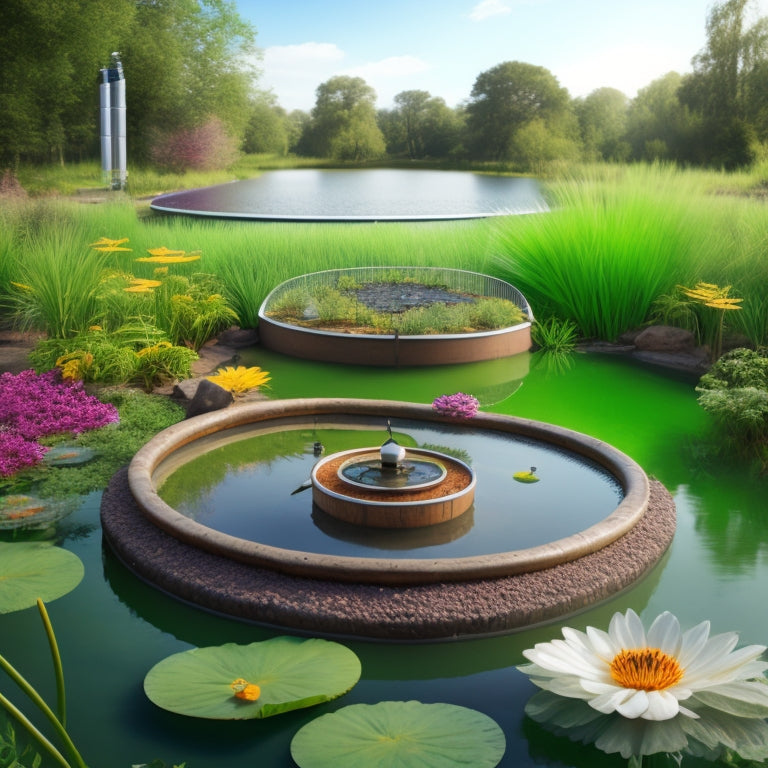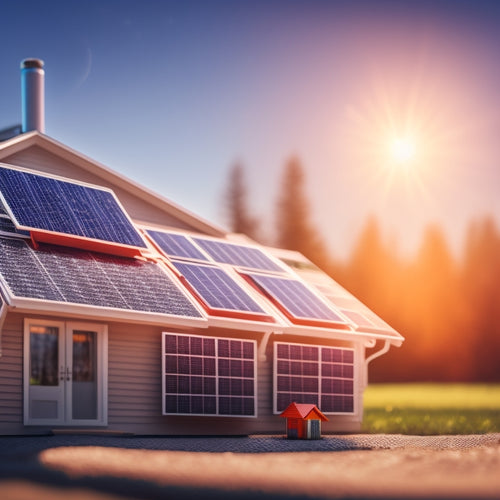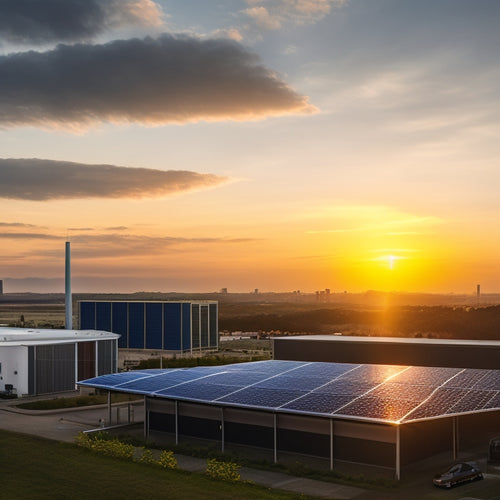
10 Essential Components for a Self-Sustaining Water System
Share
When designing a self-sustaining water system, you'll need to incorporate 10 essential components that work together to provide a reliable and efficient water supply. These components include a solar pump and energy management system, a properly sized photovoltaic array, water storage tank requirements, a water distribution network, filtration system design, pump controller and inverter, pipe materials selection, pipe sizing and network topology, monitoring and control systems, and safety measures like grounding and surge protection. With these components in place, you'll be well on your way to achieving energy independence and a reliable water supply - and that's just the beginning of your expedition to self-sufficiency.
Overview
- A solar pump with high DC voltage rating and built-in MPPT controller is crucial for efficient energy harvesting and consistent water flow.
- A well-sized photovoltaic array considering energy requirements, available sunlight, and array efficiency rating is essential for reliable energy generation.
- A durable water storage tank with adequate capacity, corrosion-resistant material, and proper installation enhances overall system sustainability.
- A well-designed water distribution network with corrosion-resistant pipes, optimized layout, and adaptable topology ensures efficient water supply and minimizes pressure drops.
- Continuous water quality monitoring and filtration system adjustments are necessary to ensure safe and reliable water supply in a self-sustaining water system.
Solar Pump Selection Criteria
When designing a self-sustaining water system, selecting the right solar pump is vital to guarantee efficient and reliable operation.
You'll want a pump that maximizes pump efficiency, securing consistent water flow and pressure. Reflect on a pump with a high DC voltage rating to optimize energy harvest from solar energy. Look for a pump with a built-in maximum power point tracking (MPPT) controller to guarantee maximum energy extraction from your solar panels.
In addition, choose a pump with a durable design and corrosion-resistant materials to withstand harsh outdoor environments.
Moreover, it's fundamental to take into account the environmental benefits of solar-powered pumps, which can lead to a significant reduction in energy costs and carbon footprint.
Water Storage Tank Requirements
In designing a self-sustaining water system, you'll need to carefully consider the water storage tank requirements to guarantee a steady supply of water for your needs.
The tank material options are essential, as they impact the system's durability and maintenance needs. Off-grid energy solutions, such as renewable energy sources, can also play an important role in powering water treatment and pumping systems, enhancing the overall sustainability of your water system.
You'll need to choose between materials like stainless steel, fiberglass, or concrete, considering factors like corrosion resistance, weight, and cost.
Next, you'll need to perform storage capacity calculations to determine the ideal tank size. This involves calculating your daily water usage, factoring in variables like climate, population, and water-intensive activities.
Filtration System Design
You'll need to design a filtration system that incorporates water quality monitoring to guarantee the system is removing contaminants effectively.
This monitoring will also inform your filter maintenance schedules, which are essential to preventing clogs and optimizing system performance. By integrating these components, you'll be able to maintain a consistent flow of clean water throughout your self-sustaining system.
Additionally, incorporating solar energy into your water system design can provide energy independence and reduce your reliance on the grid.
This not only reduces operational costs but also guarantees a reliable water supply, even in remote areas.
Water Quality Monitoring
Designing an effective filtration system requires continuous monitoring of water quality to guarantee the system's performance and longevity.
You'll want to regularly conduct water quality testing to identify potential contamination sources and verify the system is operating within ideal parameters. This includes monitoring pH levels, turbidity, and dissolved oxygen, as well as testing for bacteria, viruses, and other contaminants.
By doing so, you'll be able to detect any issues before they become major problems, confirming your water supply remains safe and clean.
Regular monitoring also allows you to make adjustments to the filtration system as needed, enhancing its performance and extending its lifespan.
Filter Maintenance Schedules
How frequently should filters be maintained to secure peak performance and extend their lifespan? The answer depends on the type of filter and its usage.
For example, sediment filters typically require cleaning every 1-3 months, while activated carbon filters need replacement every 6-12 months.
You should also perform regular performance testing to identify when filters need maintenance. Look for indicators like decreased water pressure, flow rate, or quality.
Implement efficient cleaning techniques, such as backwashing or chemical cleaning, to restore filter functionality.
Consider system upgrades or replacement when filters become clogged or damaged.
Pump Controller and Inverter
A self-sustaining water system relies on a pump controller and inverter to regulate and convert electrical power efficiently.
You'll want a pump controller that maximizes pump efficiency by adjusting motor speed to match changing water demands. This guarantees the pump operates within its ideal range, reducing energy consumption and wear on the system.
When choosing an inverter, consider the type that suits your system's needs. String inverters, microinverters, and power optimizers are popular options. String inverters are cost-effective, while microinverters provide individual panel monitoring and optimization. Power optimizers offer a hybrid approach, combining the benefits of both.
Photovoltaic Array Sizing
Your self-sustaining water system's energy needs are now efficiently regulated and converted thanks to the pump controller and inverter.
Now, it's time to size your photovoltaic array to maximize solar energy efficiency. Proper sizing guarantees your system can generate enough power to meet your water demands while minimizing environmental impact.
You'll need to evaluate factors like your system's energy requirements, available sunlight, and the array's efficiency rating. A well-sized array will provide reliable energy, reduce your reliance on non-renewable sources, and help you achieve energy independence.
Mounting and Tracking Systems
The photovoltaic array, now sized for ideal energy generation, requires a sturdy mounting system to securely fasten it to your roof or ground.
You'll need to choose a mounting technique that suits your specific installation, considering factors like wind load, weight capacity, and adjustability.
A reliable tracking system is also essential to maximize energy output. This involves accurately aligning the array with the sun's movement to optimize energy generation.
You'll want to prioritize tracking accuracy to guarantee your system operates at peak performance.
Water Distribution Network
You'll need to select the right pipe materials to guarantee durability and resistance to corrosion, factoring in aspects like water quality and environmental conditions.
Next, you'll design the network layout to optimize water flow and minimize pressure drops, bearing in mind the system's topology and demand patterns.
Pipe Materials Selection
Selecting the right pipe materials for your water distribution network is crucial, as it directly impacts the system's durability, maintenance needs, and overall performance.
You'll need to take into account factors like corrosion resistance, pressure ratings, and installation techniques when choosing between PVC pipes, copper tubing, PEX, and HDPE.
PVC pipes offer a cost-effective solution, while copper tubing provides excellent corrosion resistance. PEX flexibility makes it ideal for complex layouts, and HDPE durability guarantees long-term reliability.
Additionally, take into account pipe insulation to reduce heat loss and joint fittings for secure connections.
When evaluating options, weigh cost considerations against performance benefits to ascertain your system meets your needs for freedom and self-sufficiency.
Network Layout Design
With pipe materials chosen, your focus now shifts to designing an efficient water distribution network layout.
You'll need to evaluate the network topology, ensuring it's optimized for system scalability and flexibility. A well-designed layout will minimize pipe lengths, reducing material costs and energy losses.
You'll want to balance pipe sizes to maintain consistent water pressure and flow rates throughout the system. A looped or grid-like network topology can provide redundancy, allowing the system to adapt to changes in demand or component failures.
Water Pressure Management
Managing water pressure is critical in a self-sustaining water system, as it directly affects the performance and longevity of the entire network. You'll need to implement effective pressure regulation techniques to maintain a consistent flow and prevent damage to pipes and appliances. Pressure fluctuations can occur due to various causes, including changes in demand, pump failures, and pipeline leaks.
| Pressure Fluctuation Causes | Effects on the System |
|---|---|
| Changes in demand | Inconsistent water supply |
| Pump failures | Pressure surges or drops |
| Pipeline leaks | Water loss and reduced pressure |
Pressure Tank and Sensors
In a self-sustaining water system, the pressure tank plays an essential role in maintaining a consistent water supply by storing water under pressure, which is then distributed throughout the system as needed.
You'll want to verify your pressure tank's functionality is ideal, as it directly affects the system's overall performance. Proper sensor calibration is pivotal to monitor pressure levels, detecting any fluctuations or issues.
This allows you to make adjustments and maintain a stable water supply. By understanding your pressure tank's capabilities and sensor calibration requirements, you'll be able to troubleshoot issues efficiently, guaranteeing your self-sustaining water system runs smoothly and reliably, providing you with the freedom to live off the grid.
Grounding and Surge Protection
Your self-sustaining water system's reliability depends on more than just a consistent water supply; it also requires protection from external factors that can disrupt its operation. Grounding and surge protection are essential components in ensuring your system's electrical safety and reliability. Without proper grounding techniques and surge mitigation, your equipment is vulnerable to damage from lightning strikes and power surges.
| Grounding Techniques | Surge Protection Devices |
|---|---|
| Grounding electrodes | Surge suppressors |
| Bonding to a grounding grid | Overvoltage protection devices |
| Equipotential bonding | Surge arresters |
Monitoring and Control Systems
Operating a self-sustaining water system requires constant oversight to guarantee peak performance and identify potential issues before they escalate.
You'll need a monitoring and control system that provides real-time data and understandings. This is achieved through sensor integration, which collects data from various points in the system, such as water quality, flow rates, and pressure.
The data is then analyzed using advanced data analytics tools, enabling you to detect anomalies and trends. With this information, you can make informed decisions to optimize system performance, schedule maintenance, and prevent failures.
A reliable monitoring and control system enables you to take control of your water system, ensuring it runs efficiently and effectively, providing you with the freedom to focus on other aspects of your life.
Frequently Asked Questions
Can I Use a Self-Sustaining Water System for Commercial Purposes?
You can definitely use a self-sustaining water system for commercial purposes, but you'll need to assess its commercial viability and system scalability to guarantee it meets your business needs and can handle increased demand.
Are Self-Sustaining Water Systems Suitable for Areas With High Water Tables?
You'll find that 70% of the world's freshwater is groundwater, making it an essential resource. When considering self-sustaining water systems in areas with high water tables, you'll need to assess the water table impact and implement effective groundwater management to avoid contamination and guarantee sustainability.
Do I Need a Backup Power Source for My Self-Sustaining Water System?
You'll want a backup power source to guarantee continuous operation of your water system, especially during outages, to maintain energy efficiency and water availability, giving you peace of mind and independence from the grid.
Can I Install a Self-Sustaining Water System Myself or Do I Need a Professional?
You can attempt a DIY installation, but consider your knowledge in plumbing, electrical, and system maintenance before deciding; if you're uncertain, it's advised to hire a professional to guarantee a safe, efficient, and reliable self-sustaining water system.
Are Self-Sustaining Water Systems Resistant to Natural Disasters Like Earthquakes and Hurricanes?
As you wonder if self-sustaining water systems can withstand nature's fury, know that they're designed with disaster resilience in mind, ensuring structural integrity to ride out earthquakes and hurricanes, giving you peace of mind and freedom from water worries.
Ready to Buy
By incorporating these 10 essential components, you'll create a self-sustaining water system that's reliable, efficient, and environmentally friendly. You'll utilize the power of solar energy to pump water, store it safely, and distribute it effectively. With a properly sized photovoltaic array, filtration system, and monitoring controls, you'll guarantee a consistent supply of clean water. By following these guidelines, you'll be well on your way to achieving water independence, reducing your carbon footprint, and enjoying the peace of mind that comes with being self-sufficient.
Related Posts
-

A Beginner's Guide to Navigating the Solar Investment Tax Credit
You're eligible to claim a significant Solar Investment Tax Credit (ITC) of 30% of total installation costs, but mane...
-

Top 10 Off Grid Camping Gear Must-Haves
When you're off-grid camping, the right gear is crucial for a smooth expedition. Start with a durable, weather-resist...
-

Advantages of Commercial Solar Battery On-Site Storage
By investing in a commercial solar battery on-site storage system, you can greatly reduce your energy grid dependence...


